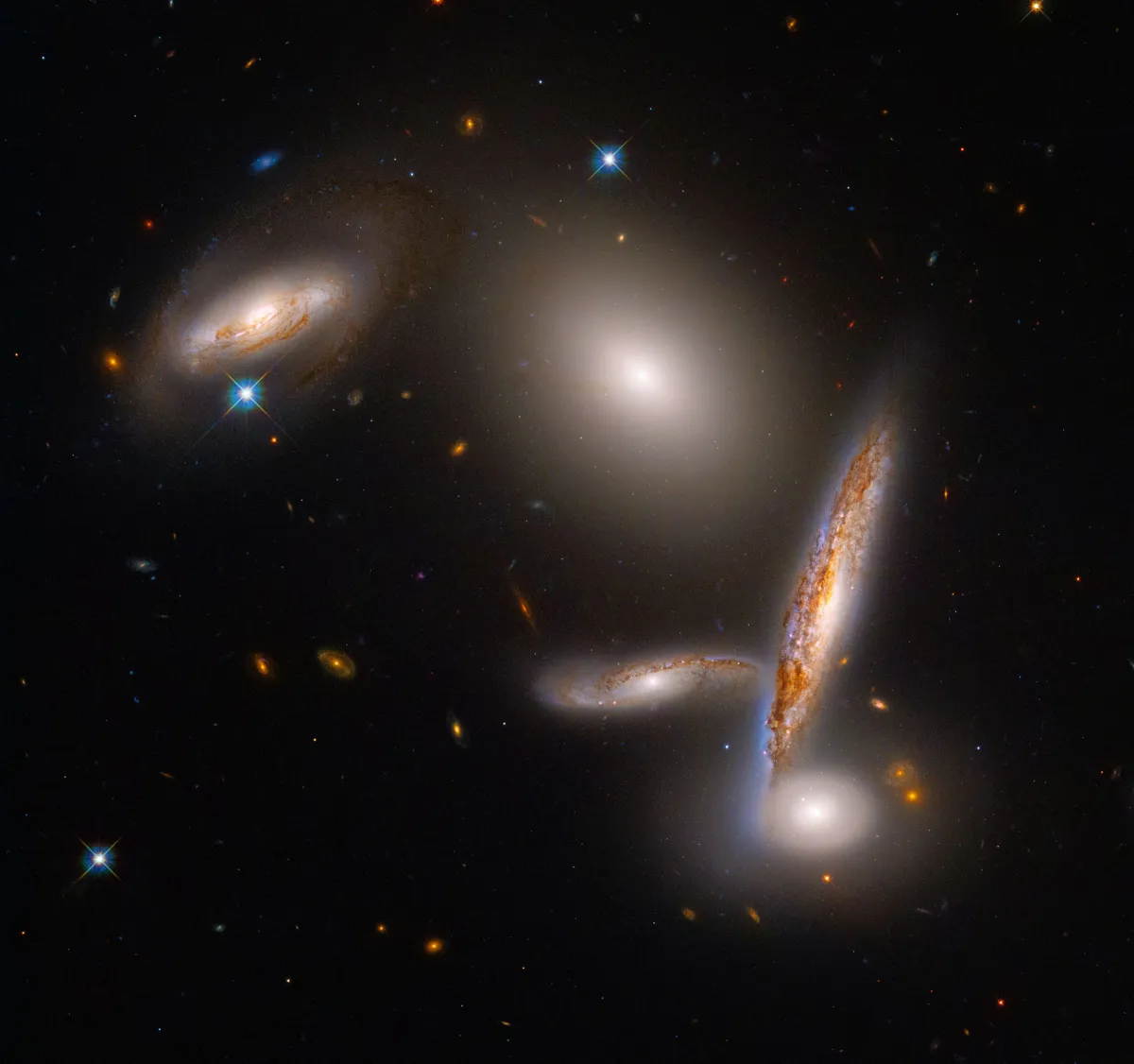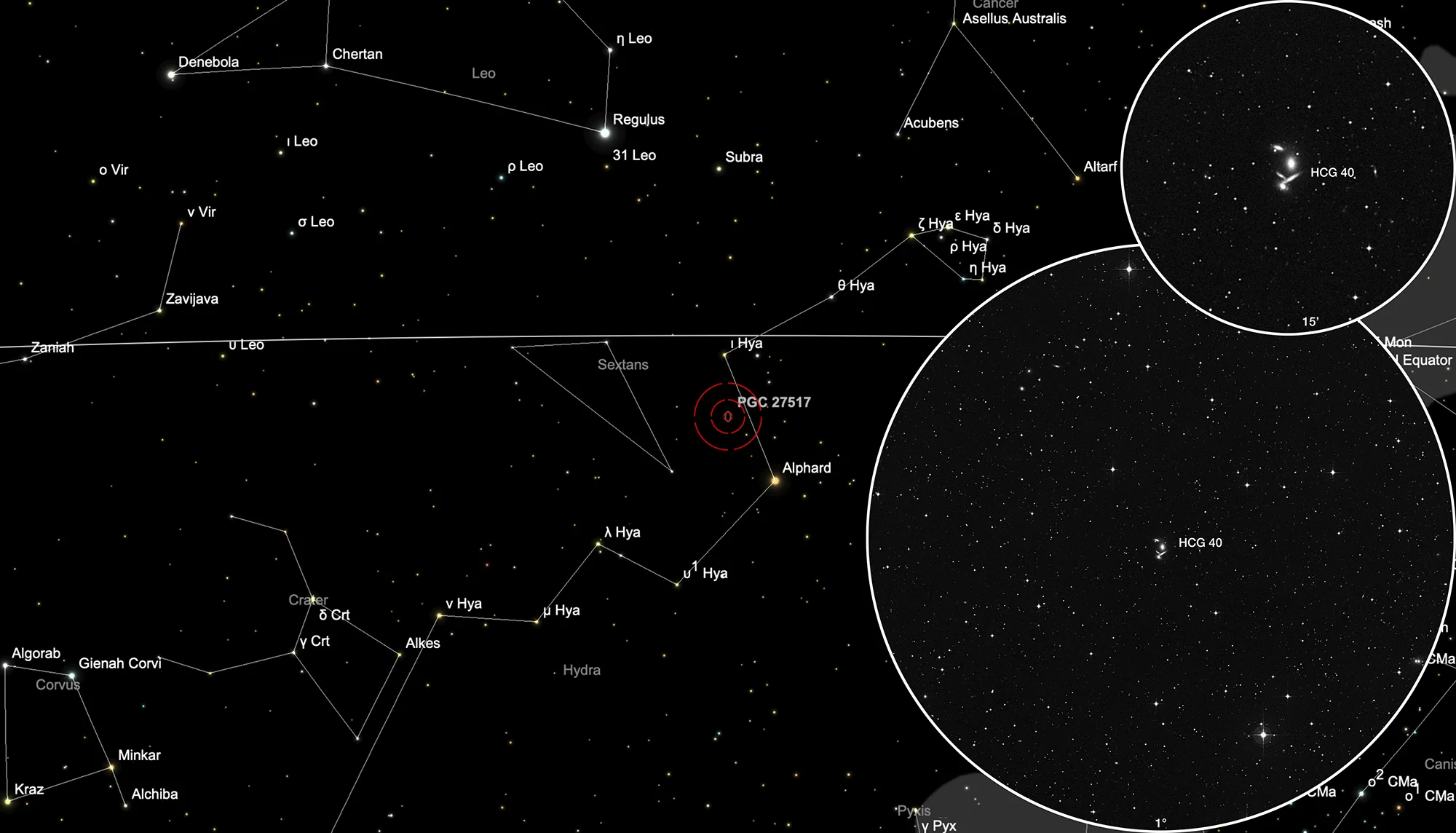Group of Galaxies Hickson 40 (Arp 321)

History
In 1959 the Russian astronomer Boris Vorontsov-Velyaminov published his «Atlas and Catalogue of Interacting Galaxies». This group of galaxies is referred as VV 116. [432]
Few years later in 1966 the American astronomer Halton Christian Arp published his «Atlas of Peculiar Galaxies», which was the result of more than four years of direct photography with the 200-inch Hale telescope of Mount Wilson and Palomar Observatories. He collected 338 unusual looking galaxies or group of galaxies. He ordered them empirically according to their form and visual appearance. Part of his discoveries was based on the Vorontsov-Velyaminov catalogue. This group of galaxies with the number 321 was arranged in group #311-321 as groups of galaxies. He noted: «VV position. Sharp absorption lane in connection to southern galaxy.» [199]
The British-Canadian astronomer Paul Hickson presented in 1982 his systematic search for groups of galaxies on the photo plates of the Palomar Observatory Sky Survey (POSS) to the public. In order to be classified by him as a galaxy group, at least four members should be identifiable, which had to be reasonably compact and isolated from the rest. The catalog contains 100 groups of galaxies. [140] The group originally had 6 members (A through F) but F was a misidentified foreground star. In the 1993 special issue of his «Atlas of Compact Groups of Galaxies» it was dropped. There he wrote «This famous and beautifoul group is also known as Arp 321 and VV 116. It is a very compact quintet of overlapping galaxies. Three galaxies are radio sources; the faintest galaxy has infrared emission.» [166]
Physical Properties
This quintet includes three spiral-shaped galaxies, an elliptical galaxy and a lenticular (lens-like) galaxy in a moment as they fall together before they merge in about one billion (109) years. The galaxies are so crowded, that they occupy a space less than twice the diameter of our Milky Way’s stellar disc. Almost every one of the galaxies has a compact radio source at its core, which could be evidence for the presence of a supermassive black hole. X-ray observations show that the galaxies have been gravitationally interacting as witnessed by the presence of a lot of hot gas amongst them. Infrared observations reveal clues to the rate of formation of new stars. [565]
| PGC | RA | Dec | Type | Dim | Btot | HRV | PA | Names |
|---|---|---|---|---|---|---|---|---|
| PGC 27508 | 09 38 53.2 | -04 51 34 | SB M | 1.1 x .3 | 15.9 | 6853 | 61 | MCG 1-25-8, (VV 116), (ARP 321), IRAS 9364-437, ANON 936-4C, HICK 40C |
| PGC 27509 | 09 38 53.5 | -04 50 56 | E M | 1.3 x 1.0 | 13.7 | 6622 | 175 | MCG 1-25-9, (VV 116), (ARP 321), ANON 936-4A, HICK 40A |
| PGC 27513 | 09 38 55.0 | -04 51 58 | L M | 1.1 x .7 | 14.9 | 6821 | 125 | MCG 1-25-10, (VV 116), (ARP 321), ANON 936-4B, HICK 40B |
| PGC 27515 | 09 38 55.5 | -04 51 28 | S M | .7 x .3 | 17.3 | 6625 | 125 | MCG 1-25-11, (VV 116), (ARP 321), ANON 936-4E, HICK 40E |
| PGC 27516 | 09 38 55.8 | -04 50 14 | SB M | .9 x .4 | 15.1 | 6466 | 80 | MCG 1-25-12, (VV 116), (ARP 321), ANON 936-4D, HICK 40D |
| PGC 27517 | 09 38 56.5 | -04 50 23 | E M | HICK 40F |
Finder Chart
The Hickson 40 compact group of galaxies can be found in the long constellation Hydra near the constellation Sextans, between the stars ι Hydrae (3.91 mag) and α Hydrae (Alphard, 1.98 mag). On 12 February it is in opposition to the Sun and crosses the meridian at local midnight. The best time for observation is in the months from October to July.
